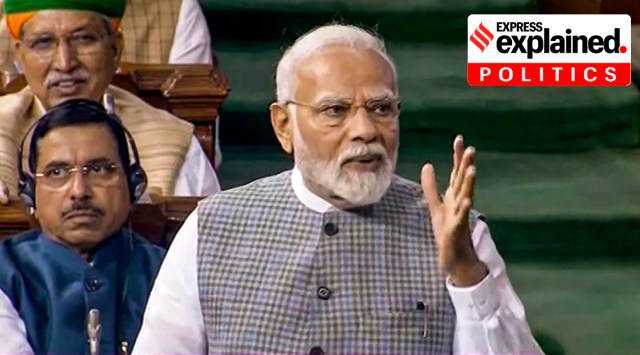Modi highlights minority govts in India: Prime Ministers whose parties had the least number of MPs in Lok Sabha
A party needs 272 or more seats in the Lok Sabha to form a government. However, there have been times when a coalition of parties, like the United Front, have come to power, delivering a prime minister, whose own party may have won only a handful of seats.
 Prime Minister Narendra Modi speaks in the Lok Sabha during a special session of Parliament, in New Delhi, Monday, September 18, 2023. (PTI Photo)
Prime Minister Narendra Modi speaks in the Lok Sabha during a special session of Parliament, in New Delhi, Monday, September 18, 2023. (PTI Photo) Prime Minister Narendra Modi on Monday (September 18) kick-started the special session of Parliament with an address in Lok Sabha, where he mentioned the historical events that took place in the old Parliament building.
Among many instances that he talked about, Modi pointed out: “This Parliament saw a party with just four MPs sitting in power, while the party with more than 100 MPs sat in opposition.”
Speaking in the Lok Sabha. https://t.co/KI5hfWRds2
— Narendra Modi (@narendramodi) September 18, 2023
A party needs 272 or more seats in the Lok Sabha (total seats are 543 plus 2 Anglo-Indian nominations) to form a government. However, there have been times when a coalition of parties, like the United Front, have come to power, delivering a prime minister, whose own party may have won only a handful of seats. Here is a look at three such prime ministers.
Chandra Shekhar (Janata Dal (Samajwadi))
In the 1989 Lok Sabha election, the Congress party suffered a huge setback after its seats plummeted to 197 from 404 in 1984. Janata Dal rose to power with 143 seats and was supported by the Left parties and the BJP from outside. V P Singh became the prime minister — the decision to give Singh the top job didn’t sit well with Chandra Shekhar, who considered himself as more worthy of the position.
 Chandra Shekhar addressing a public meeting at Chapra in Bihar on March 25, 1991. (Express archive photo)
Chandra Shekhar addressing a public meeting at Chapra in Bihar on March 25, 1991. (Express archive photo)
Therefore, Chandra Shekhar, a part of Janata Dal since 1980, left the party with 64 MPs to form the political outfit Janata Dal (Samajwadi). On November 10, 1990, he formed the government with the external support of the Congress. However, his tenure lasted for only 223 days.
H D Deve Gowda (Janata Dal)
After the 1996 Lok Sabha elections, the BJP emerged as the largest party with 161 seats. Atal Bihari Vajpayee was sworn as the prime minister but he had to resign after about two weeks as he failed to muster a majority.
 H D Deve Gowda (Express photo)
H D Deve Gowda (Express photo)
Subsequently, the United Front was formed, a coalition of 13 parties, including Janata Dal, which had 45 seats in the elections. With the help of the Congress party’s (it had won 140 seats) external support, the United Front came to power and H D Deve Gowda, who was at the time Karnataka’s chief minister, was chosen for the top job. His tenure was cut short after the Congress decided to withdraw its support. Deve Gowda was replaced by another United Front/Janata Dal leader I K Gujral.
I K Gujral (Janata Dal)
Gujral was the Minister of External Affairs in Gowda’s government before he assumed the prime ministership. He had also served as a Rajya Sabha member from Bihar and a Lok Sabha member from Punjab’s Jalandhar.
 I K Gujral at a Palam Air Force station before his departure for Maldives. (Express photo by Sunil Saxena)
I K Gujral at a Palam Air Force station before his departure for Maldives. (Express photo by Sunil Saxena)
But much like his predecessor, he didn’t stay long in the office and he had to resign within a year. The 11th Lok Sabha was dissolved and refresh elections were announced.
- 01
- 02
- 03
- 04
- 05






































